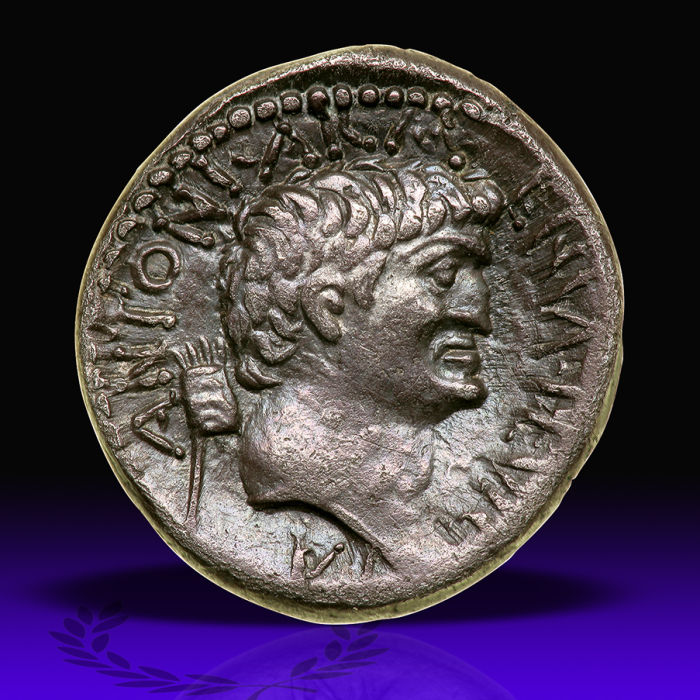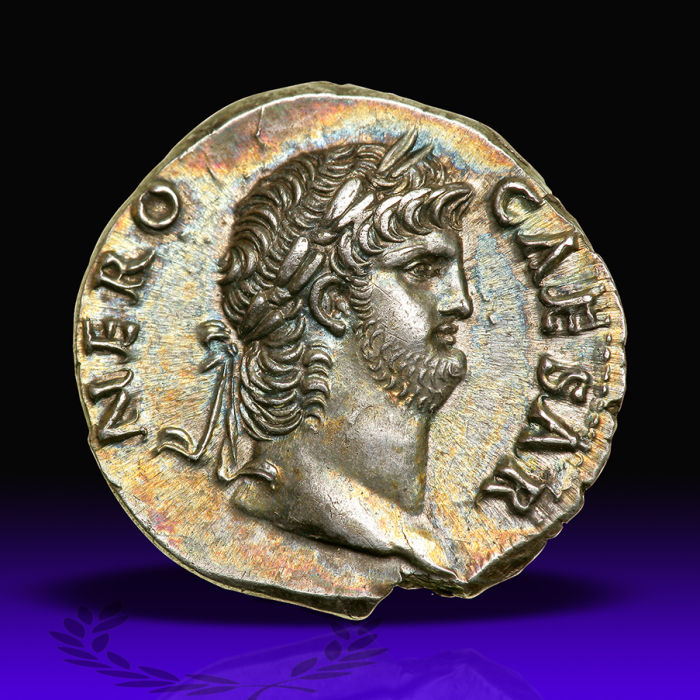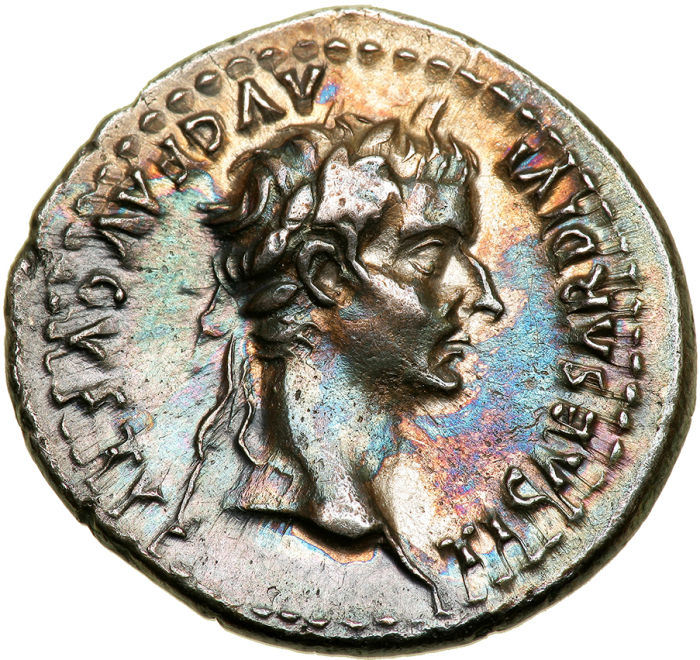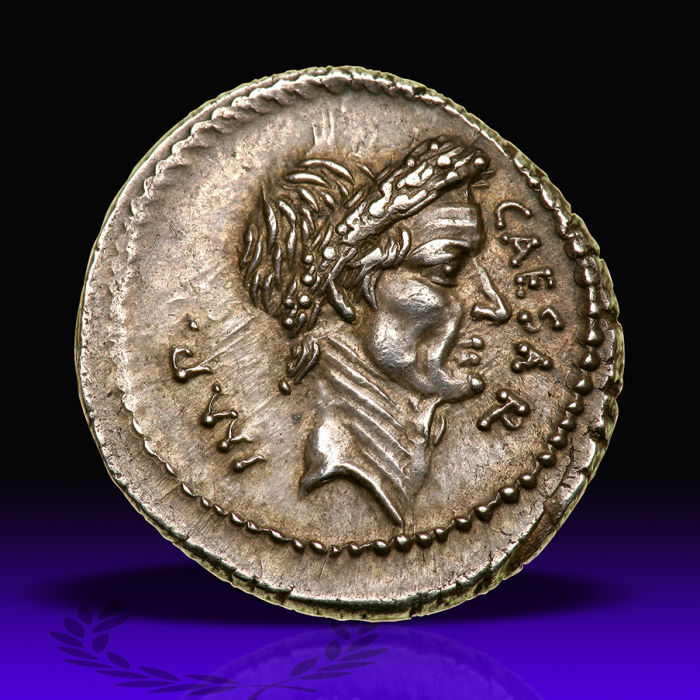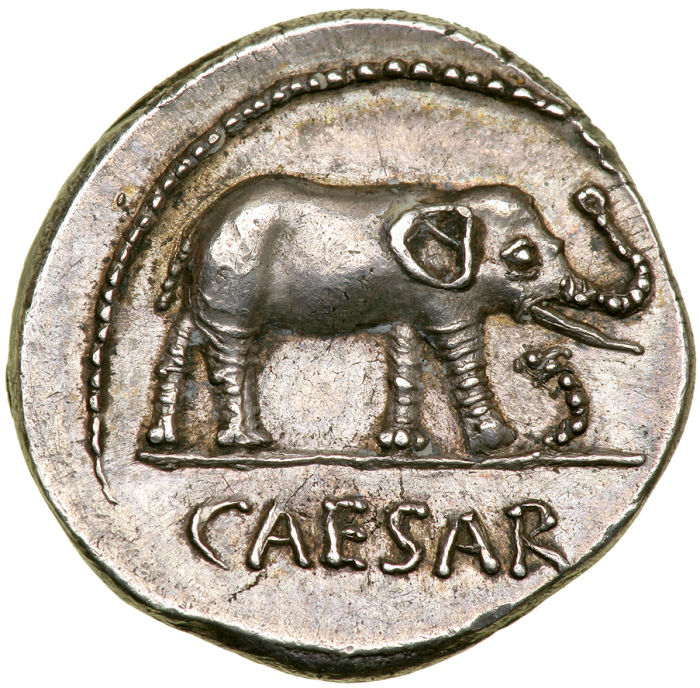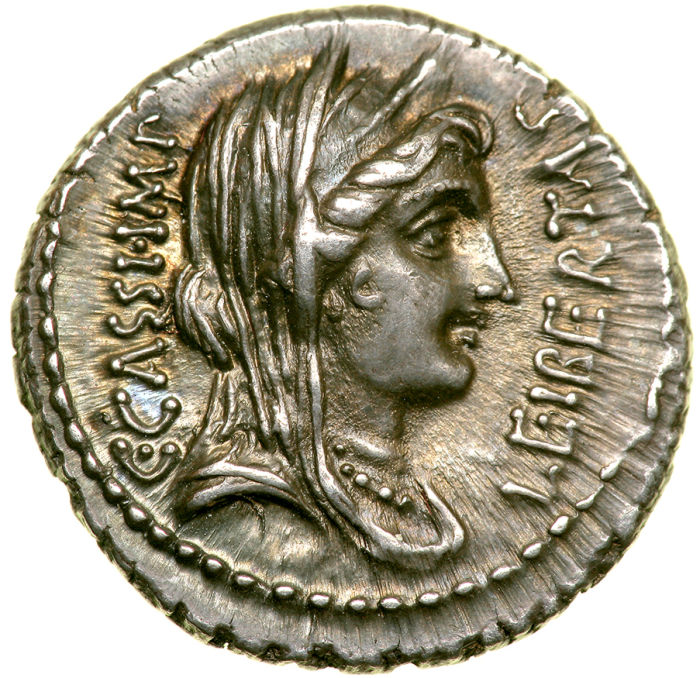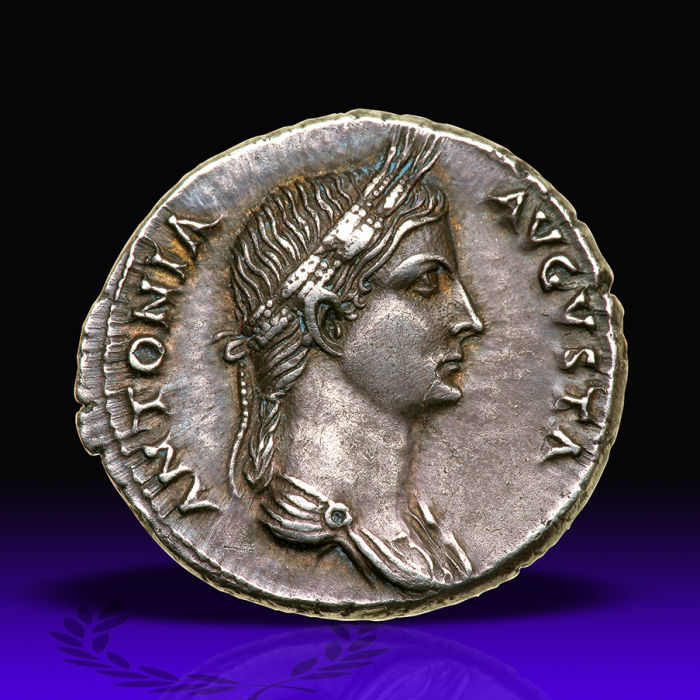|
Sextus Pompey, younger son of Pompey the Great, Silver Denarius (3.44 g), 42-38 BC. Executed 35 BC. Minted in Massilia. Q. Nasidius, commander of the fleet. NEPTVNI behind, bare head of Pompey the Great right; before, trident; below, dolphin right. Reverse Q NASIDIVS in exergue, galley with billowing sail and bank of rowers moving right; in upper left field, star. Crawford 483/2; HCRI 235; Sydenham 1350; RSC 20 (Pompey the Great). Very Rare. Well centered on a full flan with the head of Pompey in high relief. A remarkable example! Extremely Fine.
Q. Nasidius was a Pompeian loyalist, having first served under Pompey unsuccessfully defending Massalia from the Caesarian forces under Decimus Brutus in 49 BC. Later he commanded the fleet of the Pompeian forces in north Africa until the disaster at Thapsus, after which he left for Spain to join with Pompey's son, Cn. Pompey Jr. He subsequently served as supreme naval commander under Sextus Pompey at Massilia, where this handsome coin was struck. Eventually Nasidius saw the futility of the Pompeian cause, deserting to Mark Antony where he fought at Actium in 31 BC.
Estimated Value $20,000 - 25,000.
Ex S. C. Markoff Collection (NAC 62, 6 October 2011), 2002.
denarii collection - roman imperitorial |
|
|
Mark Antony & Cleopatra VII. Silver Denarius (3.63 g), 34 BC. Alexandria. ANTONI ARM-ENIA DEVIC-TA, head of M. Antony right; behind, Armenian tiara. Reverse CLEOPATRAE [REGINAE] REGVM FILIORVM REGVM, diademed and draped bust of Cleopatra right; below, prow of galley right. Crawford 543/2; HCRI 345; Newman 34.3; Sydenham 1210; RSC 1. Mostly well struck and perfectly centered with two exceptional portraits. Well toned. Extremely Fine.
In the autumn of 34 BC Antony celebrated an unusual and ostentatious (even by Roman standards) triumph through the streets of Alexandria. The event was staged to play up his successes in conquering Armenia, although he had summarily failed in the main objective of the campaign, which was the conquest of Parthia. The parade ended at the Gymnasium of Alexandria, where the entire citizen body hand been assembled to witness what has become known as the 'Donations of Alexandria'. For the spectacle, Antony and Cleopatra dressed as Dionysus-Osiris and Isis-Aphrodite, and sat upon massive golden thrones, with Cleopatra's young son by Julius Caesar, Caesarion, dressed as Horus beside them. Cleopatra's other children were dressed in the attire of the kingdoms they were to inherit. For the Donations, Antony affirmed Cleopatra as queen of Egypt, Cyprus, Libya and parts of Syria, and bestowed upon her children the eastern provinces of Rome from Cilicia to North Africa, as well as Parthia which remained unconquered. As for Caesarion, he was proclaimed the son and legitimate heir of the deified Julius Caesar, and affirmed as King of Egypt.
Antony sent an announcement to the Senate requesting confirmation of the Donations, but the Senate refused to countenance such an affront to the dignity of Rome. Ocatavian, who was Caesar's heir through adoption, was of course threatened by Antony's claiming Caesarion Caesar's legitimate heir, and this perhaps above all else led to the outbreak of the final confrontation between Octavian and Antony.
The coin is truly remarkable. Never before had the portrait of a foreign head of state appeared on a Roman coin. Additionally, the legend joined with Cleopatra's portrait proclaims "of Cleopatra, Queen of Kings and of her sons (children) who are Kings," thus affirming the Donations that Antony had bestowed. Finally, this coin uses a previously unknown die with a new legend break (DEVIC-TA). Neither are illustrated in Banti nor the photofiles of either the British Museum or the ANS.
Estimated Value $25,000 - 30,000.
Published in the Celator in 2012.
denarii collection - roman imperitorial |
|
|
Nero. Silver Denarius (3.53 g), AD 54-68. Rome, ca. AD 64/5. NERO CAESAR, laureate head of Nero right sporting slight beard. Reverse AVGVSTVS GERMANICVS, Nero standing facing, radiate and togate, holding Victory on globe and laurel branch. RIC 47; WCN 22; BMC 60; RSC 45. A wonderful bold strike on a full flan and perfectly centered. Every whisker on Nero is complete and the the facing figure of Nero on the reverse is also incredible. Lovely pastel iridescent toning on both sides adds to its appeal. Superb Extremely Fine.
Struck circa AD 64/5, this coin's reverse shows the monumental bronze statue of Nero in the guise of Sol that was originally just outside of the main palace entrance of Nero's Domus Aurea ('Golden House').
The Greek sculptor, Zenodoros, constructed the statue between AD 64 and 68, thus the representation on the coin predates the completed statue. After Nero's downfall, Vespasian replaced the head of the statue with one of the god Sol himself. In the second century, Hadrian had the statue moved adjacent to the Flavian Amphitheater, from which that building derives its popular name, the Colosseum.
Estimated Value $10,000 - 13,000.
denarii collection - roman imperitorial |
|
|
Brutus. Silver Denarius (3.52 g), 42 BC. Mint moving with Brutus in northern Greece. L. Plaetorius Cestianus, magistrate. BRVT above, IMP before, L PLAET CEST behind, bare head of Brutus right. Reverse EID MAR, pileus between two daggers. Crawford 508/3; Cahn 13b; HCRI 216; Sydenham 1301; Mazzini pl. V, 15 (same dies); Naville XV, 1315 (same dies); RSC 15. An incredible example in outstanding condition for this issue of great historical importance. Boldly struck with an incredible, well defined portrait on a full broad flan with minor porosity, all lightly toned. The ultra important reverse is simply breathtaking! Among the finest known examples. Superb Extremely Fine.
The highly provocative design of the reverse of this most famous of Roman coins, the Eid Mar denarius, presents us with the fait accompli of Caesar's assassins. The coin loudly proclaims that the hated tyrant is dead and that the deed was done in the name of liberty.
On the Ides of March 44 BC, M. Junius Brutus and C. Cassius Longinus led a host of other senators to rid Rome of Julius Caesar. Caesar had been proclaimed dictator for life and held absolute power, holding all of Rome's top offices. Many felt he aspired to become king. Not only did he already have all the powers of an absolute monarch, just three months prior to his assassination he committed his most egregious affront to Roman sensibilities when usurped the royal prerogative of placing his own image on the coinage. Never before had a living Roman's portrait appeared on the coinage, and in the minds of the conspirators this must have been the final straw, the fatal coalescing of all their enmity. Caesar paid with his life, and the fabric of the Republic was torn asunder.
It took time after Caesar's assassination for the situation to develop to the point of open civil war. At first, Antony as leader of the Senate proclaimed a general amnesty for the conspirators, but after the establishment of the Second Triumvirate between Octavian, Mark Antony and Lepidus in November 43 BC, the conspirators were declared public enemies. Being the leaders of the conspiracy to assassinate Caesar, Brutus and Cassius had long before fled Rome, their safety at risk from the Roman mob. In early 42 BC, however, they joined forces at Sardes in Asia Minor and began preparations for the final showdown with the triumvirs. By the summer they were in Macedonia en route to engage the forces of Antony and Octavian.
The first battle of Philippi took place to the west of the town on October 3. Brutus faced Octavian while Cassius engaged Antony. Brutus successfully pushed back the forces of Octavian, but those of Cassius were routed by Antony, and on hearing a false report that Brutus had been defeated and killed, Cassius committed suicide. The second battle took place on October 23 and saw the combined forces of the conspirators under the sole command of Brutus. They proved no match for the triumvirs, however, and Brutus was soundly defeated. Seeing that all was lost, he too committed suicide.
The Eid Mar denarius was struck to pay Brutus' troops and campaign expenses. His choice of types are both appropriate on the one hand and ironic on the other. The reverse depicts the pileus, or cap of liberty traditionally given to slaves when they were freed, between the daggers representing the death of Caesar, while the legend EID MAR records the date the Republic was released from Caesar's tyranny. The message is unequivocal and follows the long Roman tradition of proclaiming illustrious events of one's family on the coinage. Of course, what was more important for Brutus than his own involvement in the restoration of the Republic by ridding it of Caesar? The obverse is different, however. If the appearance of Caesar's portrait on coinage was the final straw that precipitated the actions of the conspirators, then surely it would be improper (ironic even) for Brutus to place his own portrait on his coins. However, by this time the triumvirs were already placing their own portraits on coins (see Crawford 494), and Brutus was merely following their footsteps.
Estimated Value $250,000-UP.
denarii collection - roman imperitorial |
|
|
Tiberius. Silver Denarius (3.6 g), AD 14-37. 'Tribute Penny'. Lugdunum. TI CAESAR DIVI AVG F AVGVSTVS, laureate head of Tiberius right. Reverse PONTIF MAXIM, Livia, as Pax, seated right on throne with ornate legs, resting feet on footstool, holding scepter and olive branch. RIC 30; Lyon 150; BMC 48; RSC 16a. Well struck on a nice large flan and perfectly centered. Mottled toning. Extremely Fine.
Estimated Value $1,000 - 1,200.
denarii collection - roman imperitorial |
|
|
Julius Caesar. Silver Denarius (4.11 g), 42 BC. Rome. P. Clodius M.f. Turrinus, moneyer. CAESAR before, IMP behind, laureate head of Julius Caesar right. Reverse P CLODIVS on left, M F on right, Mars standing facing, head left, holding spear and parazonium. Crawford 494/16; HCRI 114; Sydenham 1123; RSC 37. Boldly struck on a full size flan with incredible detail. Lovely old cabinet tone with a hint of iridescense. An exceptional example, one of the finest in existence. Superb Extremely Fine.
The moneyer, P. Clodius, son of Marcus, of whom nothing is known, returned to the realistic style of portraiture that typifies Caesar's lifetime issues and which had been replaced the year before with an idealized effigy of Caesar under the moneyer Flamininus. There are parallel issues by P. Clodius for both Mark Antony and Octavian (Crawford 494/17 and 494/18 respectively), each employing the same reverse type of Mars. The issue was struck to finance the anticipated war against the republican forces of Brutus and Cassius in the East.
Estimated Value $50,000-UP.
Ex UBS 78 (9-10 September 2008), 1131; Ernst Justus Haeberlin Collection (A.Cahn/A. Hess, 17 July 1933), 2930.
denarii collection - roman imperitorial |
|
|
Julius Caesar. Silver Denarius (3.98 g), 49-48 BC. Military mint traveling with Caesar. CAESAR in exergue, elephant advancing right, trampling horned serpent. Reverse Pontifical implements: simpulum, sprinkler, axe and priest's hat. Crawford 443/1; HCRI 9; Sydenham 1006; RSC 49. Well struck in high relief with pleasing old cabinet toning. Superb Extremely Fine.
Perhaps the most ubiquitous of Caesar's denarii, this famous issue was struck at the time of his crossing of the Rubicon and the beginning of the long period of civil wars which resulted in the downfall of the Roman Republic. A few theories have been presented explaining the obverse type, the most established being that the elephant represents good, the serpent evil, thus a message of the righteousness of Caesar's cause. The reverse shows the symbols of Rome's high priest, the Pontifex Maximus, Caesar having been elected to the office in 63 BC.
Estimated Value $2,000 - 2,500.
denarii collection - roman imperitorial |
|
|
Cn. Domitius Calvinus. Silver Denarius (3.86 g), 39 BC. Osca. Imperator in Spain, 39-36 BC. OSCA, bearded male head right. Reverse DOM COS ITER IMP, simpulum, aspergillum, axe and apex. Crawford 531/1; HCRI 342; Sydenham 1358; Burgos 1509. A magnificent example, well struck and well centered. Lovely old cabinet tone with a hint of iridescense. Nearly Mint State. Rare.
Cn. Domitius Calvinus was stalwart Caesarean, having served as Caesar's Master of the Horse. He commanded the Caesarean center at Pharsalus and was present at Thapsus, and in 39 BC Octavian appointed him governor of Spain with instructions to put down a revolt of the Cerretani. The province, which had recently been ceded to Octavian after Sextus Pompey's defeat, was in a state of extreme turmoil following years of misrule and civil war. Calvinus was known as a strict disciplinarian, and was a good choice for the job as he quickly put down the revolt and restored order to the province. While in Spain he established his capital at Osca where he minted these denarii. The obverse directly copies the bearded male head found on Spanish denarii of the second and first centuries BC, and the reverse presents the symbols showing he was a member of the college of pontifices.
Estimated Value $5,000 - 7,000.
Ex NAC 52 (7 October 2009), 299; Gorny & Mosch 107 (2 April 2001), 339.
denarii collection - roman imperitorial |
|
|
C. Cassius Longinus. Silver Denarius (4.0 g), 42 BC. Military mint, probably at Smyrna. Conspirator, commited suicide in 42 BC. P. Lentulus Spinther, legate. C CASSI IMP behind, LEIBERTAS before, diademed, veiled and draped bust of Libertas right. Reverse LENTVLVS/SPINT in two lines below, jug and lituus. Crawford 500/5; HCRI 223; Sydenham 1305; RSC 6. Boldly struck in high relief and well centered. Beautifully toned with hints of iridescense. Superb Extremely Fine.
Libertas's portrait on this coin is quite lovely, showing a certain graciousness and competent ability not evident on the parallel issues with an unveiled Libertas where the goddess is depicted with a rather large jowl and chin more in line with a caricature portrait. In instances such as this, we must wonder if the engraver was simply more skilled or if perhaps he had a local beauty sit for him whose likeness he skillfully copied.
Estimated Value $4,000 - 5,000.
Ex Triton XI (8-9 January 2008), 612; Freeman & Sear List 6 (Summer 2001), F87.
denarii collection - roman imperitorial |
|
|
Antonia Minor. Silver Denarius (3.85 g), Augusta, AD 37 and 41. Rome, under Claudius, ca. AD 41-45. ANTONIA AVGVSTA, draped bust of Antonia right, hair tied in short queue at back of neck, wreathed with grain ears. Reverse CONSTANTIAE AVGVSTI, Antonia, as Constantia, standing facing, holding long torch and cornucopiae. RIC 66; BMC 111; RSC 2. An incredible example, boldly struck in high relief, on a full size flan and perfectly centered. Excellent metal and attractive old cabinet toning. Among the finest in existance. Superb Extremely Fine.
Antonia was the younger daughter of Mark Antony and Octavia in 36 BC. In either 18 or 16 BC, she married Nero Claudius Drusus, to whom she bore three children: Germanicus, Livilla and Claudius. Although initially honored with the title of Augusta by her grandson, Caligula, she eventually fell out of favor with him, committing suicide in AD 37 possibly as a result. Her son Claudius reconfirmed the title on her posthumously in AD 41.
RIC notes that the reverse of this type emphasizes Antonia "as the model for Claudius' Constantia and also as the priestess of Divus Augustus, from whom imperial auctoritas ultimately flowed."
Estimated Value $20,000 - 25,000.
Ex Tradart (12 December 1991), 251; Fred Baldwin Collection (Glendining, 20 November 1969), 35.
denarii collection - roman imperitorial |
|


